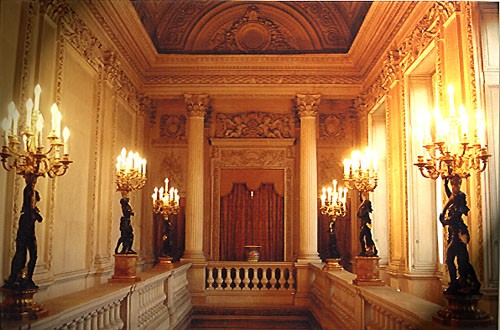The Hôtel de Monaco was built between 1774 and 1777 for Marie-Catherine de Brignole, the estranged wife of Honoré-Camille-Léonor Grimaldi, prince of Monaco, himself residing in the Hôtel Matignon. Marie-Catherine chose this site (one of the last unbuilt plots on the faubourg Saint-Germain) so as to be close to the Palais Bourbon, the house of her lover, the Prince de Condé. The project was given to Brongniart, the architect of most of the mansions in the area and he decided upon a novel scheme, distancing the house from the street by means of an avenue of plane trees which still today leads up to the façade facing the front courtyard. The private apartments give on this courtyard and the reception rooms run alongside the garden which in those days stretched as far as the Hôtel de Biron.
In 1790, with the revolution in full swing, the Princesse de Monaco with the Prince de Condé left the country – they were to be married several years later. The hôtel was the sequestrated and rented out as an embassy – the Turkish embassy, for example, took up residence in 1790. Between 1800 and 1808 the house was the property of Emmanuel Sieyès. In 1809 it was sold to Davout and on his death, in 1823, the hôtel was once again rented out as an embassy.
In 1838 Madame Davout sold the Hôtel de Monaco to the banker William Williams Hope, who had part of the structure demolished in order to rebuild the hôtel in the style which was to triumph during the Second Empire, namely, Eclecticism. A style created during the Louis-Philippe period but which reached full maturity during the reign of Napoleon III, Eclecticism took its inspiration from all the styles of the past. And the results were as often ugly pastiche as they were able interpretations. The exterior of the house was rebuilt following Brongniart's original schemes reusing the idea of the colonnade for the façade, but this time the colonnade was rectilinear and not (as it had been originally) curved, thus creating an unfortunate and obvious dissonance. For the interior, Hope turned to one of Brongniart's pupils, Achille-Jacques Fédel, a skilled ornamentalist who turned the hôtel into a sumptuous palace. Indeed the rooms become progressively more luxurious as the visitor enters the house, beginning with the sober entrance hall, then coming to the second more ornate vestibule with its fluted columns and monumental staircase with coffered ceiling lit by candelabra along the walls (see above illustration). This leads to the ostentatious dining room, the reception salons, and the final apotheosis, the vast music room drowned in a sea of gilt, stuccho and rare-wood parquet with marquetry.
Decorative ensembles of this period are sufficiently rare as to be admired for their true value when they are well preserved. The Hôtel de Monaco has come down to us relatively intact because of the committment of the various owners to preserving the extraordinary magnificence of the interior just as it was, despite the fact that the style passed very much out of fashion. In 1855 Baron Achille Sellières continued the construction work begun by his predecessor. In 1873, Jeanne Talleyrand de Perigord, Princess de Sagan, inherited the house and gave sumptuous parties there, amongst which the famous Bal des Animaux described by Proust in Le côté de Guermantes. In 1909 Jacques Seligman used the hôtel to house his collection, and finally in 1936 the mansion became the Polish Embassy. And despite a brief interim period during the Second World War when the building was used by the Germans as their Office of Culture, it has remained the property of the Polish state ever since.
Hôtel de Monaco, Paris


